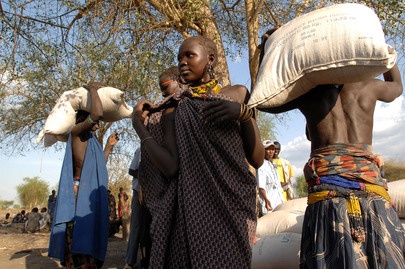
According to the World Bank’s quarterly Food Price Watch report, prospects for decline in 2012 food prices remain favorable, due to weaker consumer demand as a result of a sluggish global economy, expected declines in the price of energy and crude oil, and strong forecasts for 2012 food supplies. Nevertheless some upward price pressures still remain. These include a possible increase in demand for biofuels if oil prices pick up again, very low stock-to-use levels for maize, volatility in oil prices as a result of unrest in producer countries, and weather changes. La Niña, for instance, has already made its presence felt in the Pacific Ocean and is expected to affect the growing season of maize and soybeans in Argentina and Brazil.
Unseasonal increases in cereal prices threaten to deteriorate food insecurity conditions, especially in conflict-affected areas in Africa and across southern Somalia. In addition, the adoption of some coping mechanisms in poor homes—from eating cheaper meals to taking children out of school—could have negative, long-lasting effects on the health and well-being of millions of families in already difficult situations. Therefore, more and well-targeted support to help people cope is needed, such as school food programs, conditional cash transfers, and food-for-work programs. Read “Land Grabbing Threatening Food Security” -
diplomaticallyincorrect.org/films/blog_post/land-grabbing-threatening-food-security-by-ambassador-mo/35743
Despite the downward trend over the last few months, global prices of key staples continued experiencing volatility, and the average annual prices of wheat, maize and rice well exceeded averages for 2010. "Global food prices declined by 8 percent during the period between September and December 2011 basically because of better than expected production in major countries like China, India, Ukraine, Russia, Argentina, Australia. However, prices remain high and volatile and the average for 2011 was 24 percent higher than 2010. We also saw sharp increases in domestic prices especially in East Africa and West Africa, due to bad weather conditions and conflict. Because of these high prices we must remain vigilant because high prices may have devastating nutritional consequences which bear repercussions on school performance, health status, cognitive development and on productivity," citing José Cuesta, Senior Economist, the World Bank.
"We recommend a variety of policies; one is oriented to compensate for the negative impacts of high prices, especially through safety nets as well as medium to long term investments in agriculture especially on productivity and climate smart agriculture policies. Policies may be very effective in reducing the effects of high prices and we know that conditional cash transfers and school food programs can be effective in reducing the incentive for families to take kids out of a school to work, cash transfers may also give additional resources to avoid adjustments in their diets of the poor households and food for work programs can be a substitute for informal jobs." “State of Food Insecurity in World 2011” -
diplomaticallyincorrect.org/films/blog_post/state-of-food-insecurity-in-world-2011-un-report-by-ambassador-mo/36153 )
"Global food prices declined by 8 percent during the period between September and December 2011 basically because of better than expected production in major countries like China, India, Ukraine, Russia, Argentina, Australia. However, prices remain high and volatile and the average for 2011 was 24 percent higher than 2010. We also saw sharp increases in domestic prices especially in East Africa and West Africa, due to bad weather conditions and conflict. Because of these high prices we must remain vigilant because high prices may have devastating nutritional consequences which bear repercussions on school performance, health status, cognitive development and on productivity." See FILM REPORT – “Billion to Sleep Hungry” -
diplomaticallyincorrect.org/films/movie/billion-to-sleep-hungry/24674
Domestic food prices also experienced sharp increases in many countries from December 2010 to December 2011. Wheat prices were up 88 percent in Belarus and 23 percent in Ethiopia; rice prices increased 81 percent in Uganda and 56 percent in Malawi; maize was up 117 percent in Kenya and 106 percent in Mexico; and sorghum increased 57 percent in Burkina Faso and 28 percent in Ethiopia. Last Article -
www.filmannex.com/posts/blog_show_post/food-prices-downward-trend-after-record-surge-by-ambassador-mo/43579
By Ambassador Muhamed Sacirbey –Twitter @MuhamedSacirbey
Facebook – Become a Fan at “Diplomatically Incorrect”
Twitter – Follow us at DiplomaticallyX
International Financial Crisis Channel -
diplomaticallyincorrect.org/c/international-financial-crisis

